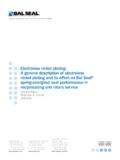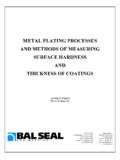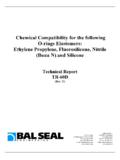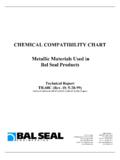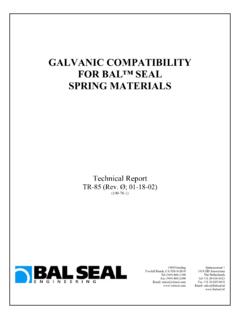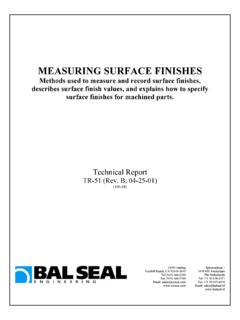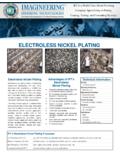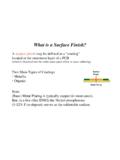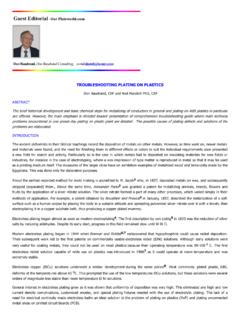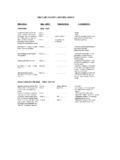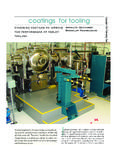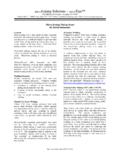Transcription of METAL PLATING PROCESSES AND METHODS OF …
1 METAL PLATING PROCESSES AND METHODS OF MEASURING SURFACE HARDNESS AND THICKNESS OF COATINGS Technical Report TR-#105(Rev. ) 19650 Pauling Foothill Ranch, CA 92610-2610 Tel (949) 460-2100 Fax (949) 460-2300 Email: Spinozastraat 1 1018 HD Amsterdam The Netherlands Tel +31 20 638 6523 Fax +31 20 625 6018 Email: Use or disclosure of data contained on this sheet is subject to the restrictions contained in the disclaimer located in the Table of Contents of this report.
2 Bal Seal Engineering Co, Inc. Foothill Ranch, CA USA 92610-2610 Tel: 949 460-2100; Fax: 949 460-2300 Email: Web: Bal Seal Engineering Europe, Amsterdam, The Netherlands Tel: +31 20 638 6523, Fax: +31 20 625 6018 Email: Web: TR-105 (100-97) Rev / 10-27-03 Page 2 of 15 Overview Summary Coating Types Electro-deposited / electroplating Electroless Hard anodizing Carburizing / carbonizing PVD/CVD Plasma spray coating Cost Coating Measurement Hardness
3 Rockwell Brinell Vickers Microhardness Cost Thickness X-ray fluorescence Eddy current Magnetic Beta backscatter Cost References The information, descriptions, recommendations and opinions set forth herein are offered solely for your consideration, inquiry, and verification and are not, in part or in whole, to be construed as constituting a warranty, expressed or implied, nor shall they form or be a part of the basis of any bargain with Bal Seal Engineering.
4 If any sample or model was shown to or provided by Buyer/User, such sample or model was used merely to illustrate the general description and type of goods. Such use is not to be construed as a warranty that the goods will conform to the sample or model. Furthermore, THE IMPLIED WARRANTY OF MERCHANTABILITY AND FITNESS FOR A PARTICULAR PURPOSE AND ALL OTHER WARRANTIES, IMPLIED OR EXPRESSED, ARE EXCLUDED AND SHALL NOT APPLY. This document provides product options for further investigation by Buyers/Users having technical expertise.
5 The Buyer/User, through its own analysis and testing, is solely responsible for making the final selection of the products and for assuming that all performance, safety and warning requirements for the application are met. It is recommended that Buyers/Users run evaluation testing under actual service conditions to determine whether proposed Bal Seal products are suitable for the intended purpose. Nothing contained herein or in any of our literature shall be considered a license or recommendation for any use that may infringe patent rights.
6 (LE-17) PATENTS: The items described in this report include products that are the subject of the following issued United States patents: 5,979,904; 5,994,856; 6,050,572; 5,984,316; 6,161,838 and others, as well as foreign patents or products where patents are pending. (LE-88G) Copyright 2003 Bal Seal Engineering Co., Inc. TABLE OF CONTENTS Use or disclosure of data contained on this sheet is subject to the restrictions contained in the disclaimer located in the Table of Contents of this report.
7 Bal Seal Engineering Co, Inc. Foothill Ranch, CA USA 92610-2610 Tel: 949 460-2100; Fax: 949 460-2300 Email: Web: Bal Seal Engineering Europe, Amsterdam, The Netherlands Tel: +31 20 638 6523, Fax: +31 20 625 6018 Email: Web: TR-105 (100-97) Rev / 10-27-03 Page 3 of 15 OVERVIEW PLATING is the application of a surface finish to another material; it provides the surfaces of manufactured parts with a number of desirable physical, chemical, and appearance qualities.
8 Nearly all manufactured or fabricated products made of METAL or having METAL components have some type of surface finishing. PLATING increases sturdiness, prevents corrosion, provides hardness, or gives an attractive finish to an object. SUMMARY Electroplating is inexpensive, reliable, efficient, and applicable to a wide variety of shapes and sizes. However, traditional electroplating technologies often result in uneven surface finishes, and have inherent pollution problems. Electroless PLATING has increased in popularity due to improvements in solution stability, pretreatment cycles, reducing agents, and equipment.
9 In addition, electroless PLATING provides uniform thickness and deposits, especially in deep recesses, bores, and blind holes. Alternative PLATING METHODS such as PVD, CVD, and thermal spraying reduce the amount of contaminated wastewater produced by PLATING , but have high unit- PLATING costs. COATING TYPES There are 46 different PROCESSES regulated under METAL finishing standards featuring different technologies, operational steps, inputs, and outputs. Some of the more common PLATING technologies are the following: Electrodeposited / electroplating Electroplating is used to change the surface properties of a METAL part by adding a METAL coating by the action of electric current; it is also called "electrodeposition,".
10 The object to be coated receives a negative charge and is immersed into a solution that contains a salt of the METAL to be deposited. The metallic ions of the salt carry a positive charge and are attracted to the object. Surface pretreatment by chemical or mechanical means is important for electroplating, as the successful adhesion of the surface coating depends on removing contaminants and films from the substrate. In addition, the geometric shape and contour of the object affects the thickness of the deposited layer.
